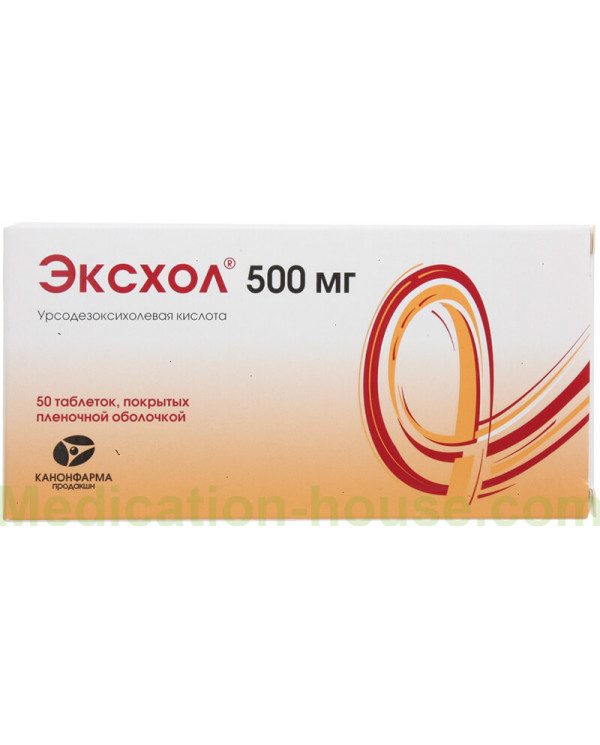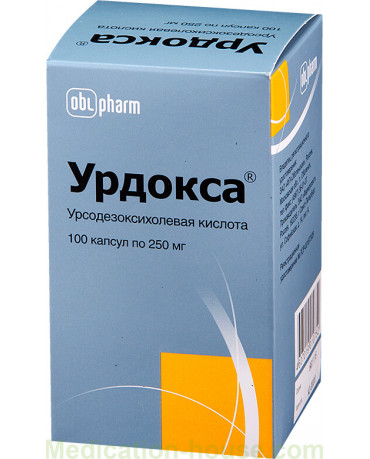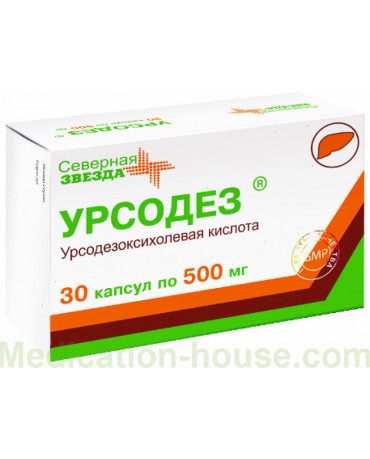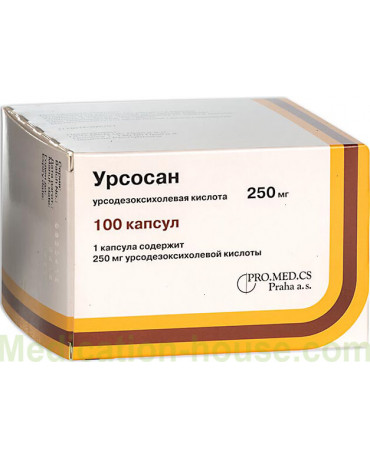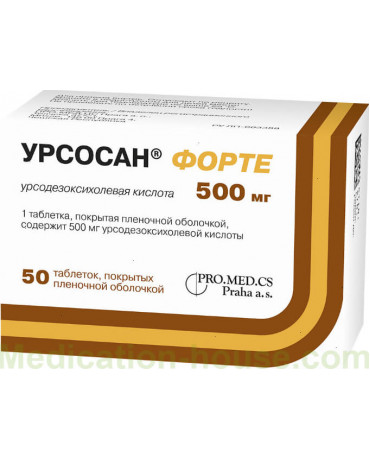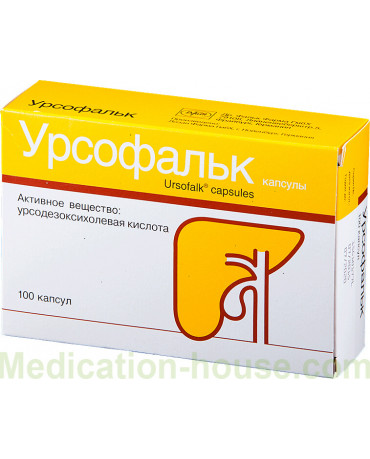Instruction for Exhol
You can buy Exhol here
Release form and composition
Exhol dosage forms:
capsules: hard gelatinous, white body / cap, size No. 0; the capsules contain almost white or white powder, the presence of granules is permissible (10 or 15 pcs. in blisters, 1, 3, 5 or 10 or 2, 4 or 6 packages are placed in a cardboard box, respectively; 50 or 100 pcs. in banks, 1 can is placed in a cardboard box);
film-coated tablets: oval, the core and the shell are almost white or white, with a risk (10 pcs. in blisters, 1, 3, 5 or 10 packs are placed in a cardboard box; 50 or 100 pcs. in cans, 1 can is placed in a cardboard box).
Composition of 1 tablet:
active ingredient: ursodeoxycholic acid - 500 mg;
additional components: calcium hydrogen phosphate dihydrate - 40 mg; calcium stearate - 7 mg; sodium carboxymethyl starch - 28 mg; potato starch - 33.5 mg; mannitol - 58 mg; macrogol (polyethylene glycol 4000) - 3.5 mg; povidone K30 - 30 mg;
shell: Opadry white (hypromellose - 6.75 mg; talc - 4 mg; hyprolose - 6.75 mg; titanium dioxide - 2.5 mg) - 20 mg.
Pharmacodynamics
Exhol is one of the hepatoprotective agents. It also has hypolipidemic, cholelitholytic, hypocholesterolemic, choleretic and insignificant immunomodulatory effects.
UDCA (ursodeoxycholic acid) has high polar properties. Due to the formation of non-toxic mixed micelles with apolar (toxic) bile acids in reflux esophagitis and biliary reflux gastritis, the likelihood of damage to cell membranes by gastric refluctate decreases.
In addition, the substance forms double molecules that can be incorporated into cell membranes (cholangiocytes, hepatocytes, epithelial cells of the gastrointestinal tract), stabilize them and reduce their susceptibility to the action of cytotoxic micelles. With a decrease in the concentration of bile acids, which have a toxic effect on liver cells, UDCA helps to resolve intrahepatic cholestasis.
Other effects of the drug:
slowing down the progression of fibrosis in primary biliary cirrhosis, cystic fibrosis and alcoholic steatohepatitis;
reducing the likelihood of esophageal varicose veins;
slowing down the processes of premature aging and cell death (cholangiocytes, hepatocytes, etc.);
normalization of natural killer activity of lymphocytes, inhibition of the expression of HLA-1 antigens on the membranes of hepatocytes and HLA-2 on cholangiocytes, etc. (immunostimulating effect);
a decrease in the saturation of bile with cholesterol, which occurs due to the inhibition of its absorption in the intestine, suppression of synthesis in the liver and a decrease in secretion into bile;
an increase in the solubility of cholesterol in bile (due to the formation of liquid crystals with it);
decrease in the lithogenic index of bile.
As a result of the use of Exhol, cholesterol gallstones are dissolved, and the formation of new calculi is prevented.
Pharmacokinetics
UDCA is absorbed in the small intestine and ileum (through passive diffusion or active transport, respectively). After oral administration of 50 mg Cmax (maximum concentration of the substance) in the blood plasma after 30, 60, 90 minutes is 3.8, respectively; 5.5 and 3.7 mmol / L. Time to reach Cmax - 1-3 hours.
UDCA has a high degree of binding to plasma proteins - 96–99%. When taken regularly, it becomes the main bile acid in the blood serum, in the blood it is approximately 48% of the total amount of bile acids. Penetrates the placental barrier. The therapeutic effect is determined by the concentration of the substance in the bile.
Metabolism takes place in the liver. It is metabolized to glycine and taurine conjugates, which are secreted into bile. Approximately 50–70% of the total dose is excreted in bile. Not absorbed UDCA in small quantities enters the large intestine, where it is broken down by bacteria (7-dehydroxylation); some of the formed lithocholic acid is absorbed from the large intestine, the rest is sulfated in the liver and is rapidly excreted in the form of a sulfolitocholyltauric / sulfolitocholylglycine conjugate.
Indications for use
dyskinesia of the biliary tract;
primary sclerosing cholangitis;
alcoholic liver disease;
cystic fibrosis (cystic fibrosis);
non-alcoholic steatohepatitis.
Additionally for Exhol tablets:
dissolution of small / medium-sized cholesterol stones in the absence of gallbladder dysfunction;
primary biliary cirrhosis of the liver in cases where there are no signs of decompensation (as symptomatic therapy);
hepatitis of various etiologies in the chronic course;
biliary reflux gastritis.
Contraindications
X-ray positive gallstones (in the presence of a high calcium content);
non-functioning gallbladder;
infectious diseases of the intestines, bile ducts / bladder in an acute course;
liver cirrhosis in the stage of decompensation;
severe renal / hepatic impairment;
lactation period;
age up to 3 years;
the presence of hypersensitivity to the components of the drug.
Additionally for Exhol tablets:
pancreatitis;
body weight up to 34 kg.
Due to the possibility of difficulty in swallowing capsules for children 3-4 years of age, Exhol in this dosage form should be prescribed with caution.
During pregnancy, capsules / tablets can only be taken after a benefit / risk ratio has been evaluated. During therapy, women of childbearing age are recommended to use non-hormonal contraceptive drugs.
Instructions for the use of Exhol: method and dosage
Exhol is taken orally without chewing, with a sufficient amount of water.
Recommended dosage regimen:
cholesterol stones of the gallbladder (to dissolve): 10 mg / kg per day (once a day at night) for 6-12 months; after dissolving the stones, for the purpose of prevention, it is recommended to continue taking Exhol for several months;
biliary reflux gastritis (therapy): 250 mg daily, at bedtime; the duration of the course - from 10-14 days to six months, it is possible to increase the duration of the course to 2 years;
primary biliary cirrhosis (symptomatic therapy): 10-15 mg / kg per day (if necessary - up to 20 mg / kg), in the first 3 months of treatment, the daily dose is divided into 2-3 doses, after improvement of hepatic parameters, it can be taken in the evening 1 time in a day. The duration of therapy is not limited. At the beginning of the course, there is rarely a worsening of clinical symptoms (increased itching). In such cases, the daily dose is reduced, then it is gradually increased (once every 7 days) to the recommended dose;
non-alcoholic steatohepatitis, chronic hepatitis of various origins, alcoholic liver disease: 10–15 mg / kg per day in 2–3 doses for a long time (6–12 months and longer);
cystic fibrosis: 20-30 mg / kg per day in 2-3 divided doses; course duration - from 6 months to several years;
primary sclerosing cholangitis: 12-15 mg / kg per day (possibly 20 mg / kg) in 2-3 divided doses; course duration - from 6 months to several years;
biliary dyskinesia: 10 mg / kg in 2 divided doses; course duration - from 14 days to 2 months.
If necessary, the course of treatment is recommended to be repeated.
For children from 3 years of age, Exhol is prescribed in a daily dose of 10–20 mg / kg.
Side effects
Estimation of the frequency of occurrence of violations (> 10% - very often;> 1% and <10% - often;> 0.1% and <1% - infrequently;> 0.01% and <0.1% - rarely; <0 , 01% - very rare).
digestive system: often - loose stools, diarrhea (may be dose-dependent); very rarely in patients with primary biliary cirrhosis - transient decompensation of liver cirrhosis (reversible);
skin: very rarely - allergic reactions (including urticaria);
liver / biliary tract: very rarely - calcification of gallstones, in patients with advanced biliary cirrhosis - decompensation of liver cirrhosis (is reversible).
Overdose
Overdose has not been reported.
If necessary, symptomatic therapy is carried out.
Special instructions
In order for dissolution therapy to be successful, it is necessary that the stones are purely cholesterol in diameter up to 15–20 mm, while the biliary tract must fully maintain its function, and the gallbladder can be filled with stones no more than half.
When using Exhol to dissolve gallstones, it is necessary to control the activity of hepatic transaminases, alkaline phosphatase, gamma-glutamyltransferase, and bilirubin concentration. Cholecystography in the first 3 months of treatment should be performed every 4 weeks, then once every 3 months. It is recommended to monitor the effectiveness of therapy during the first year every 6 months during an ultrasound scan.
If the increased rates persist, Exhol is canceled. After complete dissolution of calculi for at least 3 months, it is recommended to continue taking the drug. This will help dissolve the remains of calculi, which are not detected due to too small a size, as well as to prevent recurrence of calculus. If, within 6-12 months after the start of treatment, partial dissolution of calculi has not occurred, you need to evaluate the feasibility of further taking Exhol. The detection of an unimaged gallbladder during therapy indicates that complete dissolution of calculi has not occurred and the drug must be canceled.
When diarrhea occurs, dose reduction is indicated. In cases of persistent diarrhea, therapy is discontinued.
In primary sclerosing cholangitis, it should be borne in mind that prolonged therapy with high daily doses (up to 30 mg / kg) can cause serious adverse reactions.
Application during pregnancy and lactation
pregnancy: Exhol can be used with caution after assessing the benefit / risk ratio;
period of breastfeeding: therapy is contraindicated.
Pediatric use
For patients under 3 years of age, the drug is not prescribed.
Exhol in the form of tablets is contraindicated for children weighing up to 34 kg.
Capsules for children 3-4 years old should be used with caution.
With impaired renal function
According to the instructions, Exhol is not prescribed for patients with severe renal failure.
For violations of liver function
Severe hepatic failure and liver cirrhosis in the stage of decompensation are a contraindication to taking Exhol.
Drug interactions
Possible interactions:
cyclosporine: increased absorption from the intestine, and therefore requires control of its concentration in the blood, if necessary, the dose of cyclosporine is adjusted;
antacids containing aluminum, ion-exchange resins (colestipol, colestyramine): decrease in the absorption of UDCA; in the case of combination therapy, these drugs should be taken no earlier than 2 hours after taking Exhol;
estrogens, drugs with lipid-lowering effects (especially clofibrate), progestins / neomycin: increased cholesterol saturation in bile, which may reduce the ability to dissolve cholesterol gallstones;
ciprofloxacin: decrease in some cases of its absorption.
Terms and conditions of storage
Store in a place protected from light and moisture at temperatures up to 25 ° C. Keep out of the reach of children.
Shelf life:
tablets - 2 years;
capsules - 3 years.
Reviews
According to reviews, Exhol is an affordable and effective hepatoprotector. The drug lowers the indicators of aminotransferase, bilirubin, improves the condition with gallbladder dyskinesia. Its good tolerance is also noted.
Terms of sell
A prescription is not required to buy Exhol.

